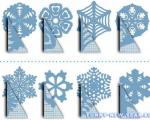Course on sensorimotor correction. Day 1
Tatyana Germanovna
Candidate of Psychological Sciences, Associate Professor of the Department of Clinical Psychology, Russian National Research University. N.I. Pirogova, Associate Professor of the Department of Neuro- and Pathopsychology of the Moscow City Psychological and Pedagogical University, Honorary Worker of the Higher vocational education RF. Specialist in child neuropsychology and psychosomatics, author of over 100 scientific publications in the field of child clinical psychology, developer original technique psychological correction.
Glukhova
Irina Leonidovna
Psychologist, graduated from the Institute of Business and Politics in 2008, in 2010 she completed retraining in clinical psychology at the Russian State University them. Pirogov. Member of the active professional Psychotherapeutic League since 2011. Has: certificate of advanced training in “Neuropsychological diagnostics and sensorimotor correction”, certificate of “Neuropsychology with neuropsychology” childhood", certificate "Desensitization and processing by eye movements", certificate "Use of photography and video to improve the Quality of Life and improvement in interpersonal and business relations" Uses art therapeutic methods of work in classes, sand therapy.
Psychologist. She has been working at the Center since 2002. Graduated from the Moscow State Open Pedagogical University named after. M.A. Sholokhov with a degree in clinical psychology in 2002. Completed advanced training in the following programs: "Psychomotor developmental environment, psychomotor correction of preschool and early childhood school age"; "Neuropsychological diagnostics and sensorimotor correction for deviations mental development"; "A "Current issues of medical psychology in child and adolescent psychiatry."Leads group classes.
Khvostenko
Elena Nikolaevna
Andreeva
Anna Vasilievna
Psychologist. She has been working at the Center since 2009. Education - Moscow State University, Faculty of Psychology, Department of Neuro- and Pathopsychology. Conducts individual and group classes on sensorimotor correction.
Lepesheva
Nadezhda Yurievna
Psychologist. Leads group and individual sessions by sensorimotor correction.
Sedova
Ekaterina Olegovna

Candidate of Psychological Sciences. She has been working at the Center since 2006. Completed advanced training in the program “Neuropsychological diagnostics and sensorimotor correction for mental development disorders.” He has scientific publications on child neuropsychology in Russian and foreign journals.
One of the most common areas of neuropsychological correction for children is sensorimotor correction . The main blocks of exercises are breathing, oculomotor exercises, stretching and so-called “crawls”. Let's look at them in more detail below. Other blocks of exercises are included in sensorimotor correction if necessary and often require less development.
Breathing exercises
At the beginning of the course, you must devote great attention production in a child correct breathing , which will optimize gas exchange and blood circulation, ventilation of all parts of the lungs, and massage organs abdominal cavity and promote overall health, improved well-being, concentration of the child’s attention and reduction of tension. One of the most important goals of organizing proper breathing in children is to form in them the basic components of voluntary self-regulation. After all, the rhythm of breathing is the only one of all bodily rhythms that is subject to spontaneous, conscious and active regulation on the part of a person. Training makes deep, slow breathing simple and natural, regulated involuntarily.
The main one is full breath, that is, a combination of breast and abdominal breathing; It must be performed first while lying down, then sitting and finally standing.
It is universal in neuropsychology to teach children four-phase breathing exercises, containing stages of equal time: “inhalation - retention - exhalation - retention.” At first, each of them can last 2-3 seconds. With gradual increase up to 7 sec.
- Starting position (IP) - lying on your back. Exhale completely, draw in air slowly through the nose, making sure that the anterior abdominal wall protrudes forward more and more (take in air freely, without straining). At the same time, the diaphragm flattens, increasing the volume of the lungs, rib cage is expanding. For 2-5 seconds. hold the air, then begin to exhale through the mouth while tightening the abdominal wall; at the end of exhalation the chest drops. Inhale and exhale smoothly, avoiding shocks.
- I.p. - lying on your back. According to the instructions of a neuropsychologist or an adult, the child begins to perform the exercise - slowly raises one hand (right, left); leg; then two limbs simultaneously inhale and hold in a raised position during the pause; slowly lowers as you exhale; relaxes during a pause.
- I.p. - sit on the floor, legs crossed, back straight. Straight arms are placed to the sides parallel to the floor. The hands are clenched into fists, except thumbs, extended outward. With an inhalation, turn your hands with your thumbs up; exhale - down. Option: arms extended forward and thumbs turn to the rhythm of breathing left and right.
- "Linear extensions." The child (first with your help) stretches his entire body, stretching with both arms and legs at the same time; then - only right side body (arm, side, leg), then - only with the left. The back should not strain or arch. Ask him if his back, arms and legs are stretched.
- "Rocking chair." Wrap your hands around your knees. Rock on your back, rolling all your vertebrae across the floor.
- "Cat". From a lying position, stand on all fours, leaning on your knees and palms; hips and arms are perpendicular to the floor. Inhale and move your head back and bend your spine down. With an exhalation - hiss; chin to chest, back arched upward.
"Stretch marks"
Tone optimization is one of the most important tasks in neuropsychological correction of the 1st level. Any deviation from the optimal tone (hypo- or hypertonicity) can be both a cause and a consequence of changes in the somatic, emotional, cognitive status of the child and negatively affect the overall course of his development.
Stretching - a system of special stretching exercises based on natural movement. When performing them, there should be a feeling of gentle stretching in the muscles, but not tension. Stretching helps children cope various kinds muscular dystonia, tension and pathological rigid bodily attitudes; optimization muscle tone and increasing the level of mental activity. When a neuropsychologist, helping a child, gives him stretches, you need to imagine that the stretches are being done to a kitten; they should be carried out in a gentle manner, slowly, not jerkily.
Oculomotor exercises
Tracking goes with his eyes behind the object located 1) at a distance arm's length, 2) at elbow distance. Consistently lying down, sitting and standing at a slow pace (from 3 to 7 seconds) with fixation in extreme positions. In this case, the hold should be equal in duration to the previous movement. When performing exercises, the child's head is always fixed. Bright objects, small toys, etc. are used to attract children's attention. First, he follows the object moved by the adult, then - his hand, which is moved by the adult. Finally, he moves it independently, holding it first in his right hand, then in his left, and then with both hands together. During the exercises, the neuropsychologist or parents should monitor the smooth movement of the child’s gaze and his stable focus on the object.
The child looks straight ahead. Begins practicing eye movements four each main directions- up, down, right, left - and four auxiliary ones: diagonally, towards oneself (bringing the eyes to the center) and away from oneself.
Formation of basic sensorimotor interactions (“Crawling”)
On formation of simultaneous and reciprocal coordination children have positive influence not only exercises involving the interaction of arms or legs, but also combined movements of the right and left halves of the body.
Crawling forward, backward, right and left (on the elbows; on the hands) with simultaneous movement arms and legs of the same name, then opposite - opposite - arms and legs. At the same time, at the beginning of neuropsychological correction in exercises, the child’s arms are located parallel to each other, then - later - they cross, that is, when moving with each “step” right hand goes behind the left one, and the left one goes behind the right one, etc. The legs move parallel to each other. At the final stage of sensorimotor correction, these exercises are performed with the child moving with a raised body on his knees and on his legs against the wall, with the addition of hand movements.
The method of neuropsychological sensorimotor correction was developed at the Department of Child Psychiatry and Psychotherapy of Medical Psychology of the Russian Medical Academy of Postgraduate Education (RMAPO) by Professor Yu.S. Shevchenko and Ph.D. psychol. Sciences V.A. Korneeva.
Neurocorrection is a set of correctional and developmental exercises that allows you to develop “problematic” lagging brain functions that were identified during a neuropsychological examination.
More than 80% of children's developmental problems are related to brain disorders and damage that occur during early stages development - during pregnancy, during childbirth, subsequently serious illnesses in the first year of a child's life. Therefore, the impact of the method of neuropsychological sensorimotor correction is not initially aimed at the development of higher mental functions, and to the basal sensorimotor level, i.e. on the development of deficit functions that were damaged during early stage child development. And only in the final part of the correctional stage does the work move into the field of cognitive psychotherapy.
Purpose of the method continuous non-drug activation of subcortical and stem structures of the brain, stabilization of interhemispheric interaction, formation of the optimal functional status of the anterior structures of the brain.
The method consists of a series of breathing and motor exercises of gradually increasing complexity, leading to the activation of subcortical structures of the brain, promoting the regulation of tone, the removal of local muscle tension, the development of balance, the release of synkinesis, the development of the perception of the integrity of the body and the stabilization of static-kinetic balance. At the same time, the operational support of sensorimotor interaction with the outside world is restored, the processes of voluntary regulation and the meaning-forming function of psychomotor processes are stabilized, focused on the formation of the optimal functional status of the anterior lobes of the brain, on the development of thinking processes, attention and memory, synesthesia and self-regulation.
Children with autism have impaired perception of the world. The child avoids some sensations, but, on the contrary, strives for others, and they turn into autostimulation. In addition, signals received from different senses do not add up to a single picture. It is no coincidence that the symbol of autism is a disassembled puzzle. The main task of neuropsychological sensorimotor correction is to teach the child to be aware of himself in space, to improve the perception of the world around him, and to develop the child’s motor, cognitive and sensory skills.
Neuropsychological sensorimotor correction is one of effective methods helping children to overcome: decreased overall performance, increased fatigue, absent-mindedness; disturbance of mental activity; decreased function of attention and memory; lack of formation spatial representations; lack of self-regulation and control in the process of educational activities.
Recovery balance between sensory and motor areas , as well as the development of both areas is main result neuropsychological sensorimotor correction. Only after recovery basic functions Maybe further development more complex (speech, thinking).
Indications for neurocorrection
Neuropsychological correction is indicated for such types of diagnosis as:
- Childhood autism
- Mental retardation (mental retardation)
- ZRR (delay speech development)
- Alalia, dysarthria
- ADHD (attention deficit hyperactivity disorder),
- Dyslexia, dysgraphia (writing and reading impairment)
- Organic disorders
- Neurocorrection effectively helps with learning problems of various types
When should you start?
The most effective method is for children aged 5 to 12 years. The sooner the disorder is diagnosed and therapy begins, the faster its results will be visible. On average, the minimum effect is achieved after 2-3 months, the maximum after 7-9 months.
In the case of organic disorders, when the child’s development is very slow, the appearance of noticeable results correctional work can last for months and even years.
Forms
Corrective work can be carried out both individually and in group form.
Neurocorrection can be carried out in the form play activities, in the form of a complex motor exercises(sensorimotor correction), breathing exercises, exercises for the development of speech and articulation
Sensorimotor correction through motor and game exercises solves the following problems:
- The child learns to feel his body and the space around him.
- Visual-motor coordination develops (eye-hand, the ability to accurately direct movement - important when writing, and not only).
- The correct interaction of arms and legs is formed.
- Auditory and visual attention develops.
- The child learns to perform actions consistently, breaking them down into a number of tasks and other important things.
Stages
Diagnostic stage. The most adequate diagnostic method in in this case is the method of A. R. Luria, adapted for children. The advantage of neuropsychological diagnostics is that it can be used to identify not only the current level of knowledge and skills of the child, but also the basic pathogenic factors leading to the observed developmental disorders.
Installation stage. Target this stage– creating in the child and his parents an active attitude towards psychocorrectional work, formation of motives for self-knowledge and self-improvement, reduction of anxiety, increased confidence in the possibility of achieving positive changes. The need for the installation stage is due in this case to the fact that quite often the use of sensorimotor correction techniques does not meet the expectations of parents who “tune in” to what they know psychological techniques, including suggestive ones. Thus, a more complete understanding of the problem and reformulation of the request occurs. To increase the effectiveness of correctional work, it is necessary to explain to parents and children (at a level accessible to them) the meaning of certain exercises performed by the child.
Correction stage: corrective action is implemented. Sensorimotor correction can be carried out both individually and in group form. The beginning of correctional work is aimed mainly at improving the functioning of subcortical structures, improving cerebral circulation, normalization of activation processes, removal of tonic disorders, increased performance. The next stage of correctional work is aimed at the development of the motor, spatial sphere, the formation of an adequate body diagram and image of the physical self, the development fine motor skills; many exercises are carried out with the aim of increasing the differentiation of brain functional systems and improving interhemispheric interaction. The last stage is aimed at increasing the level of self-regulation and voluntary control. The order in which the child performs the exercises corresponds to the direction of ontogenetic development (starting from a lying position, then sitting, on all fours, standing). Indirectly through optimization of the functioning of brain structures that regulate the work internal organs, neurohumoral and immune systems, as well as through an increase in the level of reflection and self-control, including in the sphere of physicality, the condition and somatic sphere of the child improves.
Evaluating the effectiveness of correctional work. It should be noted that the elimination of a symptom is not a sufficient reason to complete the corrective work. Positive result, expressed in the elimination of manifestations of maladjustment and previously existing violations, is not the only criterion of effectiveness. Relieving symptoms and overcoming maladaptation may be temporary. If the causative factors are not eliminated, then it is quite possible quick return the same or different symptoms. Many parents consider the ultimate goal to be the removal of the violations that were the reason for contacting a specialist. However, classes with the child must be continued to destroy the pathological mechanism, ensure the sustainability of the achieved effect, and prevent new disorders. It must be taken into account that this method there is a whole range of indirect results: for example, increasing self-esteem, self-confidence, overcoming communication difficulties. Maximum effect is achieved 7-9 months after the end of psychocorrectional influence. A delayed check should show the sustainability of the achieved results at long-term stages after completion of the correction. To take into account the effectiveness, it is advisable to carry out diagnostics using the same techniques that were used before the start of correction. In addition, the specificity of sensorimotor correction makes it possible to use objective criteria for improving the child’s condition - data medical examination And clinical trials(EEG, RheoEG, etc.). Despite the stability of the results of sensorimotor correction, repeated passage is possible correction course. This is not due to the leveling of the effects of the work performed, but to the dynamism of mental ontogenesis, changes social situation development, as well as with the impact of various negative factors(injuries, illnesses, etc.).
Thus, the process of neuropsychological sensorimotor correction is aimed at the most complete adaptation possible autistic child to life in society, to integration from special into other types of educational institutions.
Summary: Speech development. Delayed speech development. Speech development disorder. Games for developing speech in children.
Nowadays, children are increasingly experiencing delays or various disorders of speech development. A 3-year-old child who is silent, or a 4-year-old child who has “porridge in his mouth.” Now this won’t surprise anyone. Speech therapists and defectologists who conduct classes on speech development in such children focus on articulatory and finger gymnastics, development phonemic hearing. The authors of the book “Pedagogy that changes the brain” O.I. Efimov (neurologist) and V.L. Efimova (speech therapist) write that this approach to the problem of speech development in children is superficial. The authors mention that although a newborn child has a brain that has all the structures of an adult, many of these structures are not yet active. A child’s brain finally matures and becomes an adult only at the age of 18-20, for some even closer to 30.
U small child The leading role is played not by the cerebral cortex, but by subcortical structures. In their development, each child must go through certain stages of development (sensory, motor) of intelligence in order for these parts of the brain to form correctly. Developmental disorders at the stage of sensorimotor integration can lead to problems in the future, since sensorimotor integration is the basis for all learning. The authors of the book write that exercises and games aimed at developing vestibular apparatus, gross motor skills and perceptions are effective when working with children who have speech impairments or delays.
Below we provide a list of these seemingly frivolous games that can have a serious impact on the development of nervous system child.
Games to develop gross motor skills, sense of rhythm and balance
1. Play ball - any games where you need to throw, catch, or hit the ball with your hand or foot are suitable.
2. Turn the child upside down and hold him by the legs, waving him in the air.
3. Spin the child while holding his hands.
4. With kids - toss on your knees: “Over the bumps, over the bumps, into the hole - bang!”
5. Games based on the “Freeze - die” principle. For example, run and make faces until the command “freeze” is heard. After this, freeze and do not move until the command “die”.
6. Any variants of games where there are “start” and “stop” commands. For example, running a race to the corner of the house: “Ready, attention, march!”
7. Smear shaving foam on any surface with your palms.
8. Pop soap bubbles with your palms.
9. Jump rope.
10. Build “huts” from chairs, blankets, pillows, etc. and sit in them.
11. Crawl through a tunnel made of chairs.
12. Wrap the baby in a blanket like a roll.
13. Reaction games, when you need to slap your partner’s palm with your palm before he pulls his hand away.
14. "Rock, paper, scissors."
15. Stand like a stork on one leg (who can stand longer).
16. Play with balloons(toss, catch, throw over a fence, etc.)
17. Swing on a swing (a hammock is also suitable), merry-go-round, jump on a trampoline
18. Make snowmen, play snowballs, roll in the snow.
19. Train basic locomotor skills: walking, running, jumping, skipping, side steps.
20. Spin your child around in an office chair.
21. Walk like a tightrope walker on some narrow and long surface such as a gymnastic bench or beam. You can make a path on the floor from tape at home and walk along it, like on a narrow bridge over an abyss.
22. Ride a bike. The bicycle can be anything: it is important that there are pedals that you need to press with your feet in turn. It is important that the legs leave the ground. That's why children's car on rechargeable batteries, which is driven by a remote control or a button, cannot replace the most ordinary bicycle.
23. Counting tables - rhythmic pronunciation of the text in combination with hand movement.
24. Poems with movements.
25. Clap your hands to the rhythm of the music.
26. Dance rhythmically to music, sing.
Games for the development of perception
1. Tactile pouch - determined by touch, with eyes closed what is in the bag. These could be small toys, nuts, fruits, etc.
2. Distinguish between the sensations of different brushes touching the skin.
3. Smell recognition games with eyes closed.
4. Introduce different textures: knead the dough, pour in the cereal, pour in the water.
5. Place beans or peas in a large bowl and hide a few small toys, then ask the child to find them.
6. Paint with finger paints.
7. Vibration massage: electric toothbrushes, electric foot massagers, etc.
8. Regular massage, massage of the collar area is especially useful.
9. “Draw” letters or numbers on the child’s back with your finger and ask him to guess them, then switch roles.
10. Guess the taste. For example, with your eyes closed, eat a piece of fruit or vegetable and guess what it was.
11. Open and close jars, boxes, wallets, etc. with different types covers and locks.
For those who are interested in issues of sensorimotor correction, we can also recommend the following books for reading:
Material prepared by: Anna Ponomarenko
Other publications on the topic of speech development:
|






